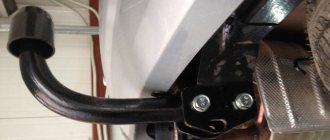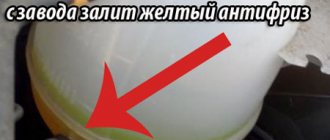12 October 2020 ADVERTISING 30 169 7
When assembling modern cars, manufacturers equip vehicles with catalytic converters. These are special devices that are built into the exhaust system to remove harmful substances from exhaust gases. To make the car more environmentally friendly, the catalyst enters into chemical reactions with dangerous compounds CO, CH and NO2, as a result of which the less harmful CO2 component is released from the exhaust pipe into the atmosphere at an acceptable concentration.
How to understand that the Lada Largus catalyst has failed
This part sooner or later fails and the driver needs to know what symptoms appear when this happens. Signs of a malfunctioning neutralizer on Largus are as follows:
- loss of power;
- increased fuel consumption;
- The Check Engine light on the dashboard is on.
To diagnose the catalyst in injection systems, an oxygen sensor is used, which is installed after the catalytic converter.
Based on the oxygen content in the exhaust gases, the injection computer, after reading the sensor readings, determines the malfunction of the converter. He reports this with a corresponding error on the panel - a burning Check Engine lamp.
The loss of power and increase in fuel consumption on Largus is due to the fact that the ceramic honeycombs become clogged and reduce the throughput of the exhaust system. The motor begins to expend more energy to push them into the atmosphere. Naturally, this affects the dynamics of the car.
At what mileage does the catalyst need to be changed – Lada Largus Club – Lada Largus forum
This article is descriptive in nature and may be relevant for any make of car.
Removing the catalytic converter on LADA Largus
Through an exhaust pipe connected to the outlet of the exhaust manifold or manifold head, the exhaust gases are directed to the catalytic converter and then to the muffler. If the V-twin engine is equipped with a single exhaust system, the exhaust gases from the two exhaust manifolds are collected into a common exhaust pipe through a Y-shaped transition provided in it. In cars with a dual exhaust system, each exhaust manifold has a separate, independent exhaust system. In most cases, the exhaust pipe is made up of several parts so that it can be mounted in the space accessible under the vehicle. A catalytic converter (afterburner) is installed between the exhaust manifold and the muffler to reduce the toxicity of exhaust gases. The neutralizer is a casing made of heat-resistant metal (Fig. 6.35), which contains a backfill of granules coated with a layer of catalyst, or a monolithic honeycomb grid coated with a layer of catalyst.
Rice. 6.35. Typical catalytic converter. The thin pipe connected to the side of its body is the air duct coming from the air injection pump. Additional air pumped by the air pump is necessary to oxidize toxic compounds and convert them into harmless H20 (water) and CO (carbon dioxide)
How the catalytic converter works
The neutralizer uses small amounts of rhodium, palladium and platinum. These chemical elements perform the function of a catalyst (a substance that stimulates a chemical reaction, but does not itself enter into it). As exhaust gases pass through the catalytic converter, the chemical decomposition of nitrogen oxides (NOx) into oxygen and nitrogen occurs in its first chamber. The second chamber of the catalytic converter oxidizes most of the hydrocarbons and carbon monoxide remaining in the exhaust gases, resulting in harmless carbon dioxide (CO2) and water vapor (H2O). A number of engine designs incorporate a continuous or pulsed air injection system to provide additional air that may be required during the oxidation process (Figure 6.36). Since the 1960s, many neutralizers have also used cerium, an element that can accumulate oxygen. The purpose of cerium is to provide oxygen to the catalyst in the case when the exhaust gas mixture is rich and oxygen is not enough to completely oxidize chemical compounds. When the exhaust gas mixture is lean, cerium absorbs excess oxygen.-
New Lada: Installing a protective mesh on the radiator grill of Lada Vesta » Lada.Online - all the most interesting and useful about LADA cars
Rice. 6.36. Cutaway view of a three-way catalytic converter showing the air injection pipe installed centrally between the reduction and oxidation chambers of the converter. Pay attention to the small holes in this pipe, designed for uniform spraying of air pumped by the air pump along the end of the rear, oxidation, chamber of the neutralizer
For proper operation of the catalytic converter, it is necessary to ensure that the composition of the exhaust gas mixture changes as it passes through the catalytic converter - from rich to lean:
• To reduce oxygen (O) from nitrogen oxides (NOx), the mixture must be enriched.
• In order for there to be enough oxygen for the oxidation of hydrocarbons (HC) and carbon monoxide (CO) (the reaction of oxygen combining with hydrocarbons and carbon monoxide, which results in the formation of water H2O and carbon dioxide COJ), the mixture must be lean.
If the catalytic converter malfunctions, it is necessary to check the correct composition of the fuel-air mixture entering the engine and the serviceability of the ignition system.
Tapping test
This simple test is as follows: Tap (lightly!) the catalytic converter body with a light rubber-faced hammer. If the catalyst substrate has collapsed, it will make a rattling sound when tapped. If the neutralizer rattles, it must be replaced (Fig. 6.37). Chapter 8 provides a detailed description of the methodology for testing the exhaust system for throughput.
Can the catalytic converter fail, but not because it is clogged with carbon deposits?
Yes maybe. Catalytic converters fail not only due to mechanical clogging, but also due to chemical damage, or poisoning. Therefore, the catalytic converter must be checked not only for physical damage (clogging) by measuring back pressure or vacuum and tapping, but also for temperature rise. This test, usually performed with an IR pyrometer or propane test, evaluates the effectiveness of the neutralizer.
New Lada: Lada Kalina does not start and the starter does not turn and the immobilizer is flashing
Rice. 6.37. This catalytic converter was ruptured as a result of an explosion of gasoline contained in the over-enriched exhaust gas mixture. Apparently pure gasoline got into the catalytic converter and all it took was a spark to cause it to explode. There is no longer any need to diagnose this neutralizer.
Rice. 6.38. The temperature at the outlet of the neutralizer must exceed the temperature at its inlet by at least 10%. This neutralizer is extremely efficient. Its inlet temperature is 450°F (232°C). Ten percent of 450°F is 45°F (450°F 45°F=495°F (257°C)). In other words, in order for the neutralizer to be considered normally functioning, the temperature at its outlet must be at least 495°F. In this case, it is 525°F (274°C) and exceeds the temperature at the inlet of the converter by more than 10%. If the neutralizer is inoperative at all, then the temperature at its outlet will be lower than the temperature at its inlet
Catalytic converters do not “die” on their own.
Catalytic converters stimulate the occurrence of chemical reactions, but do not themselves enter into them. Thus . they are not subject to wear and aging. If it is determined that the catalytic converter has failed (lost functionality or is completely clogged), look for the reason why this happened. Remember the following:
“Catalytic converters do not die on their own; their death is always caused by some external cause.”
If a catalytic converter failure is detected, all components of the ignition and fuel system must be included in the list of components to be checked. Excessive unburned fuel in the exhaust gases can cause overheating and failure of the catalytic converter. To ensure maximum efficiency of the catalytic converter, the required composition of the fuel-air mixture must be maintained, and for this the oxygen sensor must be operational and measure the oxygen content with a frequency of 0.5 to 5 Hz.
New Lada: Why does the Lada Kalina engine heat up quickly?
Video
Catalyst service life in Lada Largus
The catalytic converter has its own service life, which depends on many factors. The most important of them is the quality of the fuel used. Bad gasoline does not burn completely, its particles burn out inside the ceramic honeycombs, and the more often they come into operation, the faster the catalyst wears out.
On average, such a part in Largus can last about 100 thousand kilometers. After which it fails. The problem may occur earlier or later, depending on the gasoline used.
Why is the catalyst removed in Largus?
Faced with converter malfunctions, the car owner begins to think about replacing this part. However, its cost can reach hundreds of thousands of rubles.
The high price of an automobile catalytic converter is due to the fact that it uses alloys of precious metals. Ceramic honeycombs are coated with titanium, which comes into contact with harmful gases, burning them. Therefore, one of the reasons why the catalyst is removed is its high cost.
However, there are other reasons:
- Car chip tuning.
- An opportunity to save yourself from problems with him in the future.
- Protection of engine cylinders from particles of scattered honeycombs getting inside.
In order to save money, the average car enthusiast does not replace the catalyst. It is much cheaper and more profitable to remove all the contents of the “jar”.
Only in 10% of cases is this part replaced as part of the car’s warranty repair at an official Lada dealer.
Catalyst Largus (Largus) original for 16-valve engine 21129-10 Euro 5
| engine's type | 16 valve |
| Emission rate | Euro 5 |
| Weight, kg | 4.4 |
| Protective screen | No |
| Block material | Ceramics |
| Housing material | Stainless steel 2mm |
| car model | Lada Largus |
| Engine capacity | 1.6 l |
Catalyst Original for Lada Largus Euro 5 cars. Suitable for Lada Largus cars with a 16-valve engine produced at the Tolyatti Automobile Plant.
The difference between the original catalyst for the Lada Largus and the fakes is in the body material, which is made of high-quality stainless steel with a thickness of 2 to 8 mm. The welds are made using robotic plasma welding, due to which the seams are perfectly straight and perfectly hold the catalyst body together. A ceramic block impregnated with precious metals is used as an exhaust gas neutralizer. The advantage of ceramic blocks is the high density of cells, which have a very large area of contact of gases with the walls of the cells. Also, ceramic blocks have a much longer service life compared to catalytic blocks with metal filler. All these factors provide the original catalyst for Lada Largus with exhaust gas purification up to the Euro 5 standard.
Source
Pros and cons of removing the neutralizer
Before you decide to take this step, you should study the following table:
| pros | Minuses |
| Improving vehicle dynamics. Even without major interventions in the engine design, you can get a power increase of 3-10% by removing the “unnecessary” part of the exhaust. | An unpleasant exhaust gas odor may occur. |
| Reduced fuel consumption. The motor will spend less energy on acceleration. | Largus will switch to Euro-2 toxicity standards, which means making changes to the design of the vehicle. There is a risk of not passing technical inspection, and the road to European countries with such a car will be closed. |
| Saving money. After all, removing the catalyst is cheaper than replacing it. Often, masters are ready to do this for free, provided that the car owner hands over the old “can” to them. |
It should be noted that all the disadvantages associated with dismantling the neutralizer are conditional. An unpleasant odor is the result of this procedure being carried out incorrectly.
The smell appears due to burnout of low-quality elastic corrugation. And technical inspection issues in the Russian Federation are resolved by purchasing a diagnostic card at stations where the vehicle is not inspected.
Based on the pros and cons, we can conclude that removing the converter is the only chance to improve the technical characteristics of the Lada Largus and save money on repairs.
What causes catalytic converter failure?
Catalytic converters, which can be purchased on the website autocatalystmarket.com in Russia, have a limited service life (100-150 thousand kilometers). Over time, the internal cellular structure of the ceramic device is destroyed, and the coating with precious metals (platinum, palladium, rhodium) is depleted, as a result of which the neutralizer is no longer able to perform its function.
Malfunctioning catalytic converters
occur for various reasons:
- use of low-quality fuel with foreign impurities;
- faulty ignition or fuel supply system;
- the entry of a large amount of motor oil into the engine, due to which the fuel does not completely burn out, and soot gets into the catalyst and clogs its honeycombs;
- mechanical shocks, due to which the ceramic base of the devices is destroyed.
Regardless of the reasons for the failure of the catalyst, removing the faulty device is considered the only correct solution. But not every car owner plans to buy and install a new converter due to the high cost of such units, while continuing to drive a car without a filter device. What are the pros and cons of such a solution?
How to choose the right flame arrester for Lada Largus
After removing the neutralizer, the volume of the exhaust system will increase. In addition, the temperature of the gases will become higher. Over time, the pipe will burn out. To prevent this, instead of a catalyst, a flame arrester is installed on the Lada Largus. It reduces the exhaust temperature and acts as a resonator.
The criteria for selecting a resonator are as follows:
| Pipe diameter | The diameter of the connected part of the flame arrester must match the diameter of the pipe. In Largus it is 50 mm. |
| Length | Doesn't matter. But the longer this detail, the better. But in Largus it will not be possible to place a flame arrester that is too long if we are talking about an 8-valve engine. |
| Noise level | It all depends on preference. The quietest is with a diffuser. The noise level will be the same as in the standard configuration with a catalytic collector. |
After selecting the flame arrester, you can begin installation.
How do cars manage without converters?
It is worth highlighting such advantages
driving without a catalyst:
- there is no need to buy a new filter device, which allows you to save a large amount of money;
- Engine power increases slightly (up to 10%);
- the ability to install a 4-2-1 or 4-1 spider instead of a catalytic converter, which allows you to further increase engine power;
- reduction in fuel consumption (also about 3-10%);
- increasing the operating life of the engine by preventing the risk of ceramic dust entering the combustion chambers.
But the decision to remove the catalytic converter also has its drawbacks.
:
- a significant increase in the release of hazardous compounds into the atmosphere, which leads to a deterioration of the environmental situation in the region;
- the appearance of a toxic smell of exhaust gases, which often penetrates into the car interior (the smell of hydrogen sulfide is felt);
- increased noise during operation of the exhaust system: if you decide to remove the catalyst, it is recommended to install a flame arrester that will reduce ringing sounds (especially when driving at high speed);
- the need to install a “fake” or reflash the ECU to the EURO2 standard, since in the absence of a catalytic converter, the CheckEngine light will always be displayed on the dashboard;
- There are often problems with the first oxygen sensor.
From the above we can draw the following conclusion
: Driving without a catalyst has its own benefits and advantages for the car, but has a detrimental effect on the environment. If government agencies and environmental services notice that a car owner is driving without a working converter, he may have serious problems. Therefore, when the catalyst wears out, it is recommended to install a new filter device.
Source
Methods for removing the Lada Largus catalyst
There are three ways to get rid of the catalytic converter:
- installation of a flame arrester;
- installation of a lambda probe blende;
- universal catalyst;
Each method should be considered separately.
Removing the neutralizer and installing a flame arrester
This method is the most popular and simplest. It consists of the following steps:
- The collector is cut out together with a small section of pipe.
- A flame arrester is welded in place of the neutralizer. The connection method can be either directly or through corrugated pipes. They are more mobile and reduce vibrations.
- The engine ECU is reprogrammed so that it does not take into account the readings of the oxygen sensor.
During the welding process, other weak points in the exhaust system are also revealed. Therefore, this is an excellent opportunity to inspect and repair faulty elements.
Installing an oxygen sensor decoy
The method is similar to the previous one. The procedure is as follows:
- The catalyst is cut off.
- All its insides are shaken out and an empty “jar” is left.
- The old part is welded back in and remains part of the exhaust system.
- Instead of an oxygen sensor, a snag is screwed in, and a sensor is screwed into it.
The trick moves the lambda probe further away from the exhaust pipe so that the DC has access to more oxygen. Thus, a simple device imitates a working catalyst, which eliminates the need to flash the ECU.
Installation of a repair catalytic converter on Largus
Another way to save money is to supply a similar part, but from a different manufacturer. They are also sometimes called universal catalysts.
The essence of such a part is that it is made of cheap materials and can easily replace a failed part without consequences. Among the disadvantages:
- short service life;
- possible incompatibility that will lead to errors in the ECU;
- sizing is required;
- will not add dynamics to the car.
Due to their shortcomings, repair neutralizers are not popular.
Removing the catalyst: pros and cons
When assembling modern cars, manufacturers equip vehicles with catalytic converters. These are special devices that are built into the exhaust system to remove harmful substances from exhaust gases. To make the car more environmentally friendly, the catalyst enters into chemical reactions with dangerous compounds CO, CH and NO2, as a result of which the less harmful CO2 component is released from the exhaust pipe into the atmosphere at an acceptable concentration.
Why is the engine control unit flashed?
As mentioned earlier, the engine control unit of the Lada Largus reads the oxygen sensor and, based on the voltage measured, determines whether the catalyst is working or not.
If the neutralizer is removed, the ECU will “think” that the system is faulty, and, therefore, will go into emergency mode and turn on the Check Engine lamp.
To prevent this, a new program is installed on the computer. It no longer takes into account the oxygen sensor installed after the catalyst. In the case of a fake lambda probe, flashing the ECU is not necessary. The system will “consider” that the neutralizer is working.











